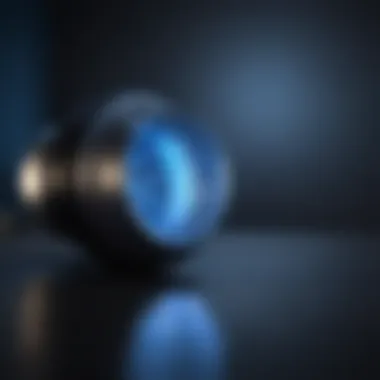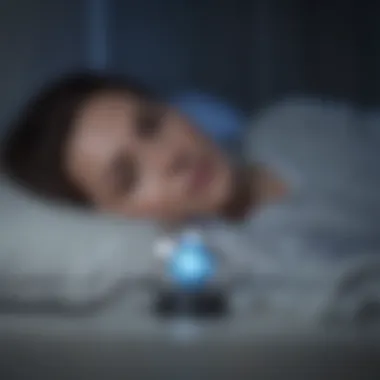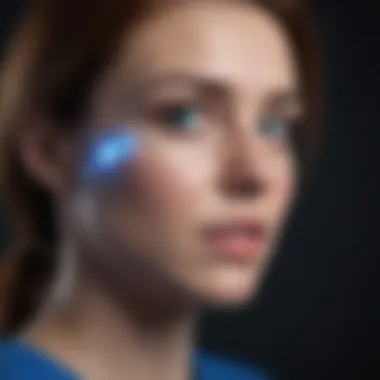The Effects of Blue Light from LED Lighting


Intro
Blue light, a portion of the visible light spectrum, has become a focal point of research and discussion in today's tech-savvy world. With the rise of LED bulbs illuminating our homes and workplaces, an intricate relationship between their emitted blue light and human health has stirred curious minds. This article delves into the myriad implications of LED-produced blue light, addressing everything from its physiological effects to environmental concerns.
Understanding the exact nature of this blue light requires us to wade through scientific studies and analyses that speak not just to the general public but also to the discerning eye of researchers and professionals in various fields. Therefore, this exploration is more than just about light; it’s about the very essence of our well-being in a society heavily reliant on artificial illumination.
Prelims to Blue Light
Understanding blue light is crucial in our tech-saturated world. With the rise in the use of LED bulbs for both home and commercial lighting, the implications of blue light exposure are a pressing concern. This section lays the groundwork for our exploration into blue light, emphasizing the need to comprehend it in terms of its characteristics and effects on human health and the environment.
Definition of Blue Light
Blue light refers to the visible light spectrum with a wavelength of approximately 380 to 500 nanometers. This range is known for its significant energy and potential impact. It exists naturally in sunlight and is essential for regulating sleep cycles, mood, and overall health. However, the spotlight often shines on its adverse effects, particularly concerning digital screens and artificial lighting, which have become ubiquitous in our daily lives.
Sources of Blue Light
Examining the sources of blue light allows us to understand where it comes from and its reach in our modern setting. Broadly, these sources can be categorized into natural and artificial ones.
Natural Sources
Natural sources of blue light primarily encompass sunlight. During daylight hours, the sun emits a wide spectrum of light, with blue light being a significant component. This natural exposure highlights why many people often feel more energized during sunny days; sunlight helps maintain our circadian rhythm, which, in essence, cues our bodies on when to wake and sleep. However, while it is beneficial, overexposure during certain times of the day can lead to negative effects such as eye strain. Therefore, adapting our outdoor activities accordingly can maximize the benefits of natural light while minimizing risks.
Artificial Sources
Artificial sources of blue light come predominantly from LED bulbs, digital screens, and fluorescent lights. These sources make up a growing portion of our daily light exposure. LEDs, in particular, are popular due to their energy efficiency and long lifespan, but they emit a higher percentage of blue light compared to traditional incandescent bulbs. The characteristic of being long-lasting and cost-efficient makes them an attractive option for consumers and businesses alike. Nonetheless, this intensity of blue light can disrupt sleep patterns and possibly lead to vision problems over time.
“LED light sources contribute significantly to overall blue light exposure, making understanding them essential for long-term health considerations.”
Recognizing the sources of blue light is the first step in navigating its effects on our health and environments. As both natural and artificial components play roles in our exposure, grasping their characteristics and impacts is necessary for any in-depth discussion on blue light.
The Role of LED Bulbs in Modern Lighting
LED bulbs have become the backbone of contemporary lighting solutions, marking a significant shift from traditional incandescent and fluorescent bulbs. The importance of this segment lies not just in the technology itself, but in the far-reaching benefits it offers, as well as the considerations that come with increasing reliance on blue light emissions.
As we unpack the role of LED lighting, it reveals several elements that contribute to its popularity, particularly the energy efficiency, longevity, and versatility of design. This technology uses less power while providing the same, if not better, lumens when compared to older lighting methods. What's more, many LEDs are designed to dim easily, allowing for a customizable light experience that meets a wide array of needs—from cozy evening lighting to bright, attention-commanding environments.
However, it wouldn’t be fair to only highlight the perks without addressing some important considerations. The blue light emissions from LED bulbs, while efficient for producing bright light, have raised concerns related to health and the surrounding environment. Therefore, a nuanced understanding of both their advantages and the implications of their light spectrum is crucial for making informed choices regarding lighting avenues in homes and workplaces alike.
Advantages of LED Technology
One of the standout features of LED technology is its impressive energy efficiency. Compared to traditional bulbs, LED lights consume significantly less electricity. For instance, an LED bulb can use up to 80% less energy than incandescent bulbs and last up to 25 times longer. This not only leads to savings on energy bills but also requires fewer replacements, making LED bulbs a cost-effective option over time.
The durability of LEDs contributes to their attractiveness as well. They are less likely to break upon impact, which is particularly useful in settings where lighting fixtures may be subject to vibrations or shocks. Plus, they can operate effectively in a wide range of temperatures, which means they perform exceptionally well in cold environments, unlike some traditional bulbs that struggle in lower temperatures.
The Spectrum of Light Output
Comparison with Traditional Bulbs
When contrasting LED bulbs with traditional incandescent and fluorescent lights, one can't ignore how their light output varies in both quality and spectrum.
Incandescent bulbs emit light as a byproduct of heat, which means they produce a broad spectrum of visible light but a lot of wasted energy in the form of heat. This leads to a less efficient lighting choice. On the flip side, LEDs project light through electroluminescence, providing a much more precise excitation of light wavelengths. With a wider spectrum and less heat generation, LEDs appeal to users who seek brighter lighting without the unnecessary heat.
The key characteristic of this comparison lies in the enhancement of visibility and clarity that LEDs provide without the substantial energy drain. As such, they are increasingly favoured for everything from home use to specific applications in art galleries and medical facilities where true color representation is essential.
Color Temperature Analysis
Diving deeper into the discussion of LEDs, it’s crucial to examine their color temperature output. Color temperature is measured in Kelvin (K) and informs how 'warm' or 'cool' a light appears. Lower temperatures (around 2700K) produce a cozy, warm light, akin to traditional incandescent bulbs, while higher temperatures (above 5000K) yield a daylight-like color that’s stark and bright.


This allows for a nuanced feature of LED lighting—adjustability in creating the desired atmosphere by simply changing the color temperature. For architects and designers, this adaptability is invaluable.
Though higher color temperatures can foster alertness during the day, thereby supporting productivity, they can also interfere with evening relaxation and sleep when used incorrectly. The trade-off here needs careful consideration, especially when one evaluates the health impacts tied with blue light emissions that are prevalent in cooler LED options.
In summary, LED bulbs not only revolutionize how we light our homes and workplaces but also necessitate an understanding of their unique characteristics and implications. As more individuals and organizations adopt this technology, they must weigh its potential against the multifaceted effects of blue light exposure.
Biological Effects of Blue Light Exposure
The biological effects of blue light exposure are critical in comprehending the implications of our modern lighting choices on health. In a world dominated by technology and LED bulbs, understanding these effects is paramount. They can affect our daily lives in subtle yet significant ways, from how alert we feel during the day to the quality of our sleep at night. The nuances of how blue light interacts with our biology inform everything from personal lifestyle choices to broader public health strategies.
Impact on Circadian Rhythms
Circadian rhythms are the internal processes that regulate our sleep-wake cycle, typically following a roughly 24-hour schedule. Exposure to blue light, especially in the evening, can throw off these rhythms. The body depends on natural light cues to signal when to produce melatonin, a hormone responsible for sleep. When blue light floods our environments, particularly from screens, we've seen a rise in difficulty falling asleep at the appropriate times. This misalignment can lead to chronic sleep issues and broader health complications, such as obesity and heart disease.
As research continues, it becomes evident that maintaining a proper circadian rhythm is vital to overall health. Thus, understanding the impact of artificial blue light is not just an academic exercise but a genuine concern for personal well-being.
Effects on Sleep Quality
The quality of our sleep is often compromised by prolonged exposure to blue light, creating a cascade of potential health issues. People are increasingly admitting they struggle to fall asleep and stay asleep on a regular basis.
Mechanisms of Disruption
One specific mechanism involved in this disruption is the suppression of melatonin production. When the brain perceives blue light, it sends signals to stay awake, interfering with the natural sleep drive. It's significant to note that this disruption doesn't only affect immediate sleep; it can also create a cycle of insomnia that becomes increasingly difficult to break. As a result, many individuals end up feeling fatigued during the day, further perpetuating a reliance on artificial stimulations like caffeine or additional screen time, fueling the cycle once again.
The intriguing factor about this mechanism of disruption is how easily it can be adjusted with behavioral changes. Some have found success in altering their screen habits, using blue light filters, or simply turning off electronic devices before bedtime.
Long-term Sleep Consequences
If the effects of blue light on sleep quality aren’t addressed, the long-term consequences can be grave. Chronic sleep deprivation has been linked to an array of physical health conditions, including cardiovascular diseases, metabolic disorders, and even mental health concerns like anxiety and depression. The unique aspect here lies in the fact that many don’t realize the connection between blue light exposure and long-term health risks until it becomes glaringly evident in their daily lives.
Moreover, this connection can sometimes lead to a daunting realization—how intertwined our reliance on technology is with our overall health. With just a few minor adjustments, however, individuals can reclaim their sleep, bolstering not only their overall well-being but their productivity and mood too.
Understanding biological effects can empower us to make informed decisions, allowing us to navigate modern life without sacrificing health.
Potential Health Risks Associated with Blue Light
Understanding the potential health risks associated with blue light is essential in today's digital age. As society increasingly relies on LED bulbs and screens, the effects of prolonged exposure to blue light are gaining attention. It is often said that knowledge is power, and having an awareness of these risks can empower individuals to make informed choices about their lighting and screen usage.
Eye Strain and Digital Eye Fatigue
In our digitally driven world, the terms "eye strain" and "digital eye fatigue" have become household discussions. Many people find themselves glued to screens for hour upon hour—be it for work or leisure. This creates a fundamental issue as blue light, particularly emitted from devices like LED screens, is known to contribute to eye strain.
The symptoms of eye strain can be varied, encompassing dryness, irritation, and even headaches. One distinctive feature is the discomfort that arises after long periods of staring at screens. People occasionally report blurred vision or difficulty focusing, which can feel like a foggy brain.
Long-term Vision Effects
The long-term effects of blue light exposure on vision are still under exploration, but research indicates a variety of potential risks. Two significant areas of concern are retinal damage studies and potential links to diseases.
Retinal Damage Studies
Studies focused on retinal damage reveal a concerning trend: some research suggests that prolonged exposure to blue light can contribute to photoreceptor cell damage in the retina. These cells play a pivotal role in visual processing. As the key characteristic of these studies shows, they focus on understanding how blue light impacts the ocular tissues. This insight becomes vital as it sheds light on the underlying mechanisms that may lead to compromised vision.
While the research is ongoing, it appears that when retinal cells are depleted of energy due to blue light exposure, they may lose their ability to function effectively. This subtle but significant change can transform into a long-term health threat, making this line of research a crucial element of our inquiry.
Potential Links to Diseases
The potential links between blue light and various diseases have raised eyebrows in the medical community. This facet includes studies connecting blue light exposure to age-related macular degeneration. This condition is a leading cause of vision loss as people grow older. The compelling feature of this area of research is its capacity to highlight future health risks—potentially serving as a warning bell for habitual screen users.


Research in this domain ranges from anecdotal evidence to clinical studies exploring the correlation. Understanding these links offers an opportunity for preventative measures, making it a valuable discussion in this article. However, one should keep in mind that while concerns exist, the actual risks require more rigorous investigation to draw solid conclusions.
Environmental Considerations
Understanding the environmental implications of blue light emitted by LED bulbs is increasingly vital, as we strive for sustainable practices in lighting technology. One may not immediately think about how the choice of a light bulb can affect ecological systems, but the truth is that every aspect of our technology has a ripple effect on the environment.
The transition to LED bulbs, while generally beneficial due to their energy efficiency and reduced carbon footprint, still carries potential downsides, particularly in terms of light pollution and its detrimental impacts on wildlife. When considering the full spectrum of LED's impact, it's essential to look beyond human health and well-being to the broader ecological canvas.
LEDs and Light Pollution
Light pollution signifies the excessive or misdirected artificial light that disrupts the natural darkness of the night sky. LED technology, especially when improperly deployed, can contribute significantly to such light pollution. The intense brightness and the spectrum of blue light emitted can confuse natural nocturnal cycles, leading to various negative consequences.
Research shows that high-intensity ambient light affects astronomical observations, but it also has societal effects, such as increased sleep disturbances in urban populations.
Some benefits of addressing light pollution include:
- Preserving Astronomy: Protecting our night sky improves astronomical research.
- Psychological Impact: Reducing artificial light promotes mental well-being by allowing natural circadian rhythms to thrive.
- Energy Conservation: Directing light appropriately minimizes waste and contributes to energy savings.
Impact on Wildlife
The effects of blue light on wildlife are profound and multifaceted. Species that rely on moonlight and natural cycles risk disruption when artificial lights flood their habitats.
Disruption of Ecosystems
Blue light can interfere with various natural rhythms, including feeding, mating, and migration cycles. For example, certain migratory birds use celestial cues for navigation. Bright artificial lights can lead them off course, disrupting their migration patterns, which can affect populations and biodiversity.
This disruption, in turn, poses risks that ripple throughout ecosystems. When one species' behavior changes, it can alter the dynamics of the entire habitat. The health of interactions among species is crucial for maintaining balanced ecosystems. Therefore, recognizing the importance of minimizing unnecessary light exposure is essential in preserving these systems.
Effects on Nocturnal Animals
The unique feature of nocturnal animals being sensitive to light conditions plays a significant role in their survival. Many mammals, such as owls and bats, rely on darkness for hunting and foraging. Artificial lighting alters their predatory dynamics and mating behaviors, leading to a declining population in some areas.
The presence of blue light can suppress melatonin production in these animals, disrupting their natural nighttime activities. With fewer animals to maintain ecological balance, the consequences can extend beyond individual species affected, affecting food chains and habitat integrity. Understanding these effects is essential for city planners and environmentalists alike, as addressing light pollution is critical for sustaining wildlife.
"The challenge of light pollution is multifaceted; it requires balancing technological advancement with ecological need. Every choice we make, from what bulbs to use to how we illuminate our cities, has an impact."
To effectively address these environmental considerations, fostering awareness about these impacts can motivate better choices in lighting technology and design. A collaborative effort between designers, ecologists, and city planners can pave the way for solutions that respect natural rhythms and promote biodiversity.
Mitigation Strategies for Blue Light Exposure
Dealing with blue light exposure isn't just a trend anymore; it's become a vital topic of discussion in today’s technology-driven society. People spend countless hours in front of screens, and the increasing presence of LED lights has heightened awareness of their potential impact. Mitigation strategies serve to tackle the issues stemming from this exposure, aiming for improved health outcomes and overall well-being. These strategies can be broadly categorized into technical solutions and behavioral adjustments, providing various avenues for individuals and institutions to explore.
Technical Solutions
Filters and Screen Protectors
Filters and screen protectors serve as a frontline defense against blue light emitted from screens. They work by selectively blocking certain wavelengths of light—specifically the blue spectrum—while allowing other, more calming light frequencies to filter through. A key characteristic of these solutions is their simplicity; they can be applied easily on most devices, making them highly accessible.
One of the most attractive features of filters and screen protectors is their passive nature. Unlike software solutions that require constant updates or adjustments, these physical tools provide an immediate reduction in blue light exposure just by being present. However, it’s worth noting that their effectiveness can vary depending on the material and brand used.
Pros:
- Immediate Protection: Install once, and you're done.
- Varied Types: Available in different styles tailored for various devices.
Cons:
- Visual Distortion: Some users report that filters can alter color appearance, which may not suit everyone, especially those in creative professions.


Smart Lighting Systems
Smart lighting systems are another increasing popular option for mitigating blue light exposure, especially in home and office environments. Unlike traditional bulbs, these systems can change color temperatures and brightness levels based on the time of day. This feature helps to align the lighting with natural circadian rhythms, promoting better sleep and reduced fatigue.
The adaptability of smart lighting is a significant advantage. Users can program the lights to change as evening approaches, decreasing the blue light levels automatically. This unique feature fosters a more sleep-friendly environment without requiring constant attention.
Pros:
- Customizable: Users can set schedules, creating tailor-made environments.
- Enhancement of Mood: Different colors can boost productivity or relaxation depending on the situation.
Cons:
- Cost: Initial setup can be pricier than traditional lighting solutions.
Behavioral Adjustments
Screen Time Management
Screen time management is about being conscious of how long we engage with screens, especially before bedtime. Setting limits on screen usage—such as using apps to track time—can actively decrease unnecessary exposure to blue light. An essential trait of screen time management is its flexibility; individuals can adjust their routines to see what works best for them.
By consciously taking breaks and limiting usage after certain hours, users promote more balanced lifestyles. This approach enables everyone to reclaim their evenings, emphasizing the importance of reducing screen time in pursuit of better rest.
Pros:
- Self-regulated: Users set their own limits, promoting a sense of control.
- Life Balance: Encourages hobbies or activities that don't involve screens, thus reducing blue light.
Cons:
- Consistency Required: Must rely on personal discipline, which can be challenging for some.
Creating a Sleep-friendly Environment
Creating a sleep-friendly environment involves more than just dimming lights; it's about shaping a second home that encourages relaxation and rest. This can include the elimination of harsh lighting at night, ensuring room darkening curtains are used, and even promoting comfortable bedroom ambiance.
A key characteristic of this adjustment is simplification. By eliminating distractions and adopting a tranquil atmosphere—like using warmer light sources in the evening—you pave the way for better sleep quality.
Pros:
- Enhanced Sleep: A properly curated environment can significantly improve sleep quality.
- Overall Wellness: Contributes to holistic lifestyle modifications that benefit mental and physical health.
Cons:
- Requires Change: This lifestyle adjustment may take time for some to embrace fully.
In summary, isolating blue light exposure through both technical solutions like filters and smart systems, as well as behavioral adjustments like screen time management and sleep environment design, actively enhances one’s quality of life. Collectively, these strategies play a crucial role in navigating our interactions with modern lighting and screen technologies.
"A stitch in time saves nine"—adopting these mitigation strategies not only addresses current concerns but also inhibits potential issues down the road.
Finales and Future Directions
The exploration of blue light emitted by LED bulbs sheds light on a significant yet often overlooked aspect of modern living. This topic encompasses various elements, from the physiological impacts on our sleep cycles to broader environmental concerns. Understanding these dimensions is paramount for both individuals and institutions aiming to mitigate negative consequences associated with prolonged exposure.
One of the core takeaways from this article is the dual-edged nature of blue light. While beneficial in promoting alertness and regulating circadian rhythms during daytime, excessive exposure, especially during the evening, can lead to sleep disturbances and health issues. The research also highlights a critical balance that needs to be maintained between harnessing the advantages of LED technology and minimizing its adverse effects.
Summary of Key Findings
- Circadian Disruption: Prolonged exposure to blue light from LED sources, particularly at night, disrupts melatonin production, leading to sleep issues. Research showed that individuals who engaged in evening screen time faced notably shorter sleep duration.
- Ocular Concerns: Continuous staring at screens illuminated by blue light can lead to digital eye strain, resulting in discomfort, headaches, and blurred vision. Notably, studies suggest a correlation between blue light exposure and potential retinal damage over time.
- Environmental Impact: Light pollution resulting from inappropriate LED usage has detrimental effects on wildlife, especially nocturnal creatures that rely on darkness for their natural behaviors.
- Innovative Mitigation Strategies: Solutions such as blue light filters, smart lighting systems, and behavioral changes can greatly reduce exposure. Implementing these strategies is vital to maintain a balanced lifestyle without sacrificing the benefits of modern technology.
Recommendations for Further Research
Moving forward, a multi-faceted approach is needed to fully comprehend the implications of blue light exposure:
- Longitudinal Health Studies: More extensive and longer-term studies should be conducted to firmly establish a link between blue light exposure and chronic health issues such as diabetes or cardiovascular diseases.
- Impact on Different Populations: Research should explore the varying effects of blue light on diverse groups, including children, the elderly, and shift workers, who may experience different patterns of exposure and sensitivity.
- Innovations in Lighting Technology: Continuous innovation focusing on creating LEDs that emit less blue light or allow for customizable color temperatures can enhance user experiences without compromising health.
- Policy Development: It’s vital to focus on developing guidelines and standards for LED usage in both residential and commercial contexts to safeguard health and well-being.
- Interdisciplinary Approaches: Collaborative research among experts in environmental science, public health, and lighting design can yield comprehensive strategies to balance technology's benefits against its risks, fostering sustainable practices.
In sum, understanding blue light's intricate role in our daily lives is not merely academic. As we navigate the bright realm of LED technology, embracing a holistic view will aid in safeguarding our health and environment. Future research will play a pivotal role in shaping informed decisions and technologies that align with our well-being.



